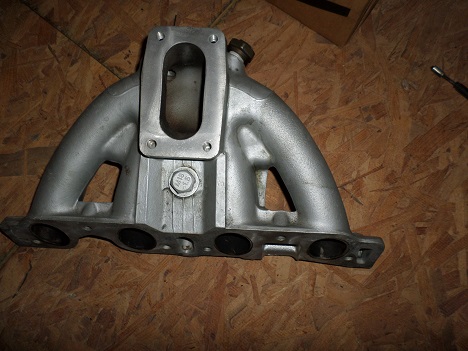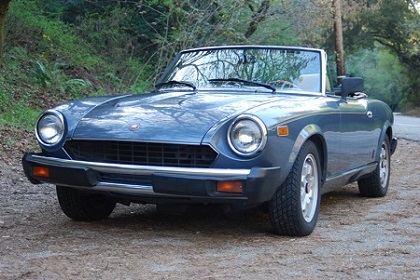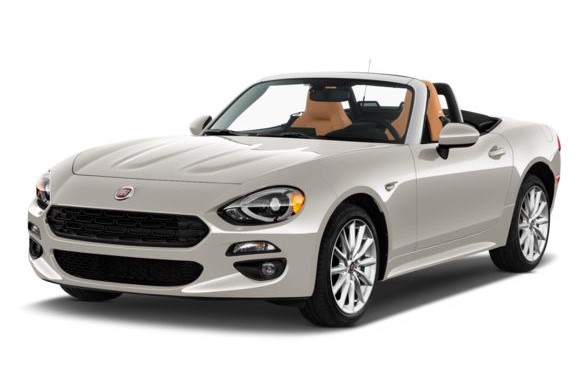Fiat Spider History 1979-1985
Starting with the 1979 model year, the Fiat 124 roadster was marketed as the Spider 2000. A minor redesign included new front grille and hood, flush-mounted door handles, taller and wider tail-lamps, and larger 14-inch wheels.

Four-wheel disc-brakes and a five-speed manual gearbox were standard equipment. No power steering was offered, nor was it needed.
____________________________________________
____________________________________________
Twin-Cam Engine
The heart of every sports car lies underneath the hood, and the Spider's twin-cam engine is a good one. The iron-block, aluminum-head engine was designed by Aurelio Lampredi, who had worked for Ferrari during their successes in the early fifties.
Starting with the 1979 Spider, engine displacement increased to 2000cc. This was achieved by keeping the 84mm bore of the previous 1800cc motor, but increasing the stroke length to 90mm. Engine compression ratio was 8:1.

The 2.0L engine had a taller block than the 1.8L motor, allowing for a longer engine stroke. The cylinder head remained the same. Although overall torque was increased, all the emission-laden engine could produce was 86 horsepower.
With a three-decades long production run, the Fiat twin-cam engine is of the longest-produced automotive engines to date.
____________________________________________
____________________________________________
Along with a revised engine for 1979, electronic unit replaced the points-style ignition. And for the first time since it's introduction in 1966, an automatic transmission was offered.
Fiat Spider Exhaust
With the exception of California-bound models, 1979 Fiat Spiders sold in the U.S. had efficient exhaust manifolds and engine pipes. The engine pipe is designed to fit a three-bolt-flange catalytic converter. The design is referred to as the 4-2-1 style (four into two into one)

The 1979 California and 1980 Spiders came with a restrictive 4-into-2 exhaust manifold. Later fuel-injected Spiders (1980-1985) used a more efficient 4-2-1 style, and a four-bolt-flange catalytic converter.
Emissions Controls
Along with AIR pumps, also added were restrictive manifolds, tiny carburetors, and scores of vacuum lines. Both performance and sales suffered.

The last of the carburetored Spiders were 1979 and early 1980 models. Because of required emissions controls, these were the worst performers in stock form, but can be retrofitted with an earlier intake manifold and carburetor.
*********************
Performance Upgrades
One of the best intake manifolds to upgrade to is the original factory piece on 1975-1978 1800cc Spiders, casting number 4264350. It is a single-plane intake manifold and will accept downdraft carbs with up to 34mm bores without modification. These manifolds can be hard to find, but they did come on other Fiat models other than Spiders.

An aftermarket carburetor like a Weber is an fairly easy bolt-on upgrade. It will add more power to a stock engine, but will be more effective with other modifications, such as the 75-78 intake manifold and exhaust headers.
Note: Replacement carbs with electric choke will make installation much easier.
*********************
Fuel Injection
Midway through the 1980 model year, fuel injection replaced carburetors. Although it was a bit complicated, Bosch's L-Jetronic system helped restore lost performance while still complying with U.S. emission regulations.
Air pumps and other emission-related hardware (and their accompanying myriad of vacuum lines) were no longer needed. Engine output increased to 102 horsepower.

Fiat Turbo Spider
During 1981 and 1982, a partnership between Fiat and Legend Industries in America produced approximately 700 Turbocharged Spiders.
For turbo-equipped cars, the stock engine compression ratio was lowered from 8:1 to 7:1, with special hoses and ducts feeding the intake charge from the turbo. A special exhaust manifold and down-pipe were used. Enrichment and over-boost switches were mounted on the left fender well. A boost gauge on the dash replaced the factory analog clock.
Turbo-Spiders came equipped with 14" alloy wheels, stripe kit, and logo decals on the fenders. With peak boost of 6 psi at 3,000 rpm, the turbocharger brought engine output to 115 horsepower.

Fiats Leaves The U.S. Market
The last year the Fiat Spider 2000 was offered in North America was 1982. Due to several issues, Fiat withdrew from the U.S. market the following year.
____________________________________________
____________________________________________
Pininfarina Spider Azzura
Malcolm Bricklin, the man behind the Bricklin sports car, recognized the appeal of the Fiat Spider and mid-engine X1/9. He launched a new company, called International Automobile Importers, with the specific purpose of importing both vehicles.
Starting with the 1983 model year, the Spider 2000 was back in America, with the Fiat name and badging gone. Now built entirely by Pininfarina, the Spider 2000 was now the Spider Azzura.
With the new name came a redesigned dashboard and center console, and minor changes in trim. The rear seat was replaced by a luggage shelf.
A European version, sold without a catalytic converter, was known as the Spider Europa. Also offered was a Europe-only, supercharged version called the Volumex.
1985 Azzura Spider
For 1985, Spiders were upgraded with rack and pinion steering and larger front disc brakes. These improvements also brought a higher price-tag, which did not help already low sales.
Pininfarina Spider production ended in 1985. Reports show about 1,500 of the final model-year Spiders produced.
***********************
Fiat Spider Production Stats
From the Fiat 124 Spider's introduction in 1966 until the 1985 Pininfarina models, nearly 200,000 units were produced.

Over 170,000 units were sold to North American markets.
Thanks to timeless styling and simple engineering, the Fiat Spider aged gracefully!
***********************
New Fiat Spider
In 2016, Fiat partnered with Mazda and resurrected the Spider name. The new model is based on Mazda's fourth-generation MX-5 Miata.

The 2016 launching coincided with the 50th anniversary of original 124 Fiat Spider.
The two cars share the same basic frame, with the Fiat getting it's own springs and anti-roll bars. Although the wheelbases are the same, the Fiat is five inches longer, and weighs about 100 pounds more. The 124 Spider also has it's own sheet metal.
With power by Fiat's turbocharged 500 Abarth engine, performance is awesome!
***********************
Related Articles: